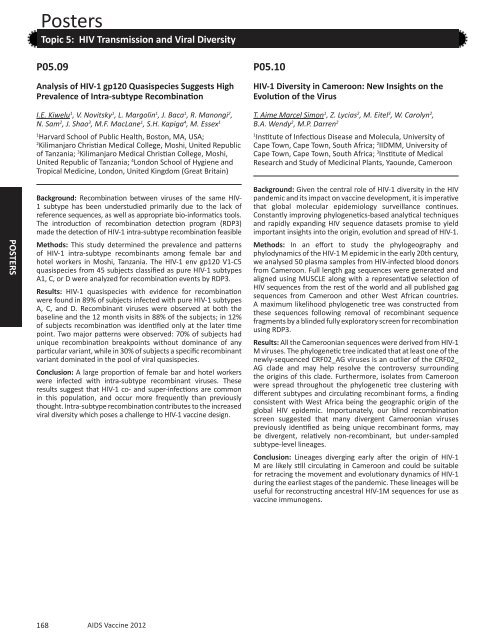Oral Abstract Session 01 - Global HIV Vaccine Enterprise
Oral Abstract Session 01 - Global HIV Vaccine Enterprise
Oral Abstract Session 01 - Global HIV Vaccine Enterprise
You also want an ePaper? Increase the reach of your titles
YUMPU automatically turns print PDFs into web optimized ePapers that Google loves.
POSTERS<br />
Posters<br />
Topic 5: <strong>HIV</strong> Transmission and Viral Diversity<br />
P05.09<br />
Analysis of <strong>HIV</strong>-1 gp120 Quasispecies Suggests High<br />
Prevalence of Intra-subtype Recombination<br />
I.E. Kiwelu 1 , V. Novitsky 1 , L. Margolin 1 , J. Baca 1 , R. Manongi 2 ,<br />
N. Sam 2 , J. Shao 3 , M.F. MacLane 1 , S.H. Kapiga 4 , M. Essex 1<br />
1 Harvard School of Public Health, Boston, MA, USA;<br />
2 Kilimanjaro Christian Medical College, Moshi, United Republic<br />
of Tanzania; 3 Kilimanjaro Medical Christian College, Moshi,<br />
United Republic of Tanzania; 4 London School of Hygiene and<br />
Tropical Medicine, London, United Kingdom (Great Britain)<br />
Background: Recombination between viruses of the same <strong>HIV</strong>-<br />
1 subtype has been understudied primarily due to the lack of<br />
reference sequences, as well as appropriate bio-informatics tools.<br />
The introduction of recombination detection program (RDP3)<br />
made the detection of <strong>HIV</strong>-1 intra-subtype recombination feasible<br />
Methods: This study determined the prevalence and patterns<br />
of <strong>HIV</strong>-1 intra-subtype recombinants among female bar and<br />
hotel workers in Moshi, Tanzania. The <strong>HIV</strong>-1 env gp120 V1-C5<br />
quasispecies from 45 subjects classified as pure <strong>HIV</strong>-1 subtypes<br />
A1, C, or D were analyzed for recombination events by RDP3.<br />
Results: <strong>HIV</strong>-1 quasispecies with evidence for recombination<br />
were found in 89% of subjects infected with pure <strong>HIV</strong>-1 subtypes<br />
A, C, and D. Recombinant viruses were observed at both the<br />
baseline and the 12 month visits in 88% of the subjects; in 12%<br />
of subjects recombination was identified only at the later time<br />
point. Two major patterns were observed: 70% of subjects had<br />
unique recombination breakpoints without dominance of any<br />
particular variant, while in 30% of subjects a specific recombinant<br />
variant dominated in the pool of viral quasispecies.<br />
Conclusion: A large proportion of female bar and hotel workers<br />
were infected with intra-subtype recombinant viruses. These<br />
results suggest that <strong>HIV</strong>-1 co- and super-infections are common<br />
in this population, and occur more frequently than previously<br />
thought. Intra-subtype recombination contributes to the increased<br />
viral diversity which poses a challenge to <strong>HIV</strong>-1 vaccine design.<br />
168<br />
AIDS <strong>Vaccine</strong> 2<strong>01</strong>2<br />
P05.10<br />
<strong>HIV</strong>-1 Diversity in Cameroon: New Insights on the<br />
Evolution of the Virus<br />
T. Aime Marcel Simon 1 , Z. Lycias 2 , M. Eitel 3 , W. Carolyn 2 ,<br />
B.A. Wendy 2 , M.P. Darren 2<br />
1 Institute of Infectious Disease and Molecula, University of<br />
Cape Town, Cape Town, South Africa; 2 IIDMM, University of<br />
Cape Town, Cape Town, South Africa; 3 Institute of Medical<br />
Research and Study of Medicinal Plants, Yaounde, Cameroon<br />
Background: Given the central role of <strong>HIV</strong>-1 diversity in the <strong>HIV</strong><br />
pandemic and its impact on vaccine development, it is imperative<br />
that global molecular epidemiology surveillance continues.<br />
Constantly improving phylogenetics-based analytical techniques<br />
and rapidly expanding <strong>HIV</strong> sequence datasets promise to yield<br />
important insights into the origin, evolution and spread of <strong>HIV</strong>-1.<br />
Methods: In an effort to study the phylogeography and<br />
phylodynamics of the <strong>HIV</strong>-1 M epidemic in the early 20th century,<br />
we analysed 50 plasma samples from <strong>HIV</strong>-infected blood donors<br />
from Cameroon. Full length gag sequences were generated and<br />
aligned using MUSCLE along with a representative selection of<br />
<strong>HIV</strong> sequences from the rest of the world and all published gag<br />
sequences from Cameroon and other West African countries.<br />
A maximum likelihood phylogenetic tree was constructed from<br />
these sequences following removal of recombinant sequence<br />
fragments by a blinded fully exploratory screen for recombination<br />
using RDP3.<br />
Results: All the Cameroonian sequences were derived from <strong>HIV</strong>-1<br />
M viruses. The phylogenetic tree indicated that at least one of the<br />
newly-sequenced CRF02_AG viruses is an outlier of the CRF02_<br />
AG clade and may help resolve the controversy surrounding<br />
the origins of this clade. Furthermore, isolates from Cameroon<br />
were spread throughout the phylogenetic tree clustering with<br />
different subtypes and circulating recombinant forms, a finding<br />
consistent with West Africa being the geographic origin of the<br />
global <strong>HIV</strong> epidemic. Importunately, our blind recombination<br />
screen suggested that many divergent Cameroonian viruses<br />
previously identified as being unique recombinant forms, may<br />
be divergent, relatively non-recombinant, but under-sampled<br />
subtype-level lineages.<br />
Conclusion: Lineages diverging early after the origin of <strong>HIV</strong>-1<br />
M are likely still circulating in Cameroon and could be suitable<br />
for retracing the movement and evolutionary dynamics of <strong>HIV</strong>-1<br />
during the earliest stages of the pandemic. These lineages will be<br />
useful for reconstructing ancestral <strong>HIV</strong>-1M sequences for use as<br />
vaccine immunogens.


